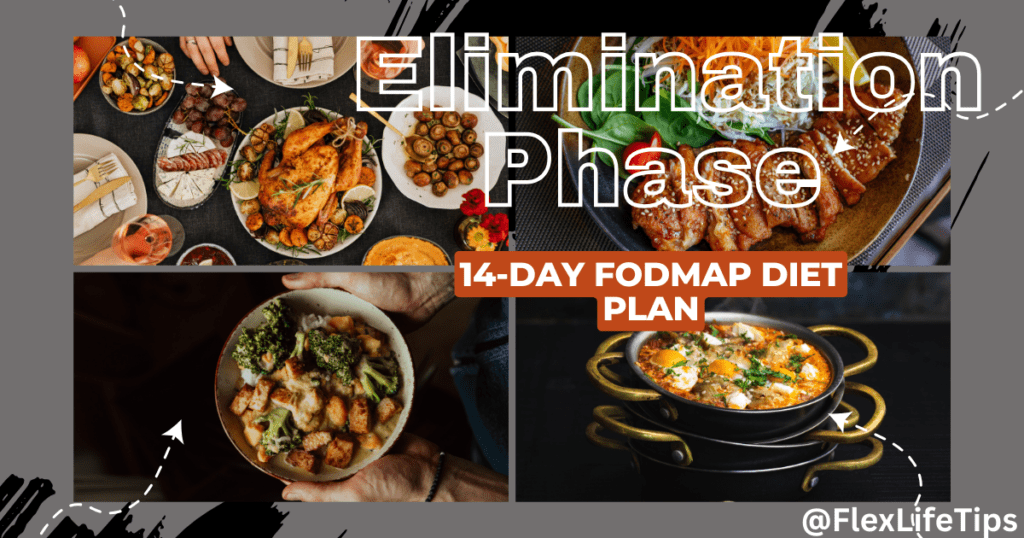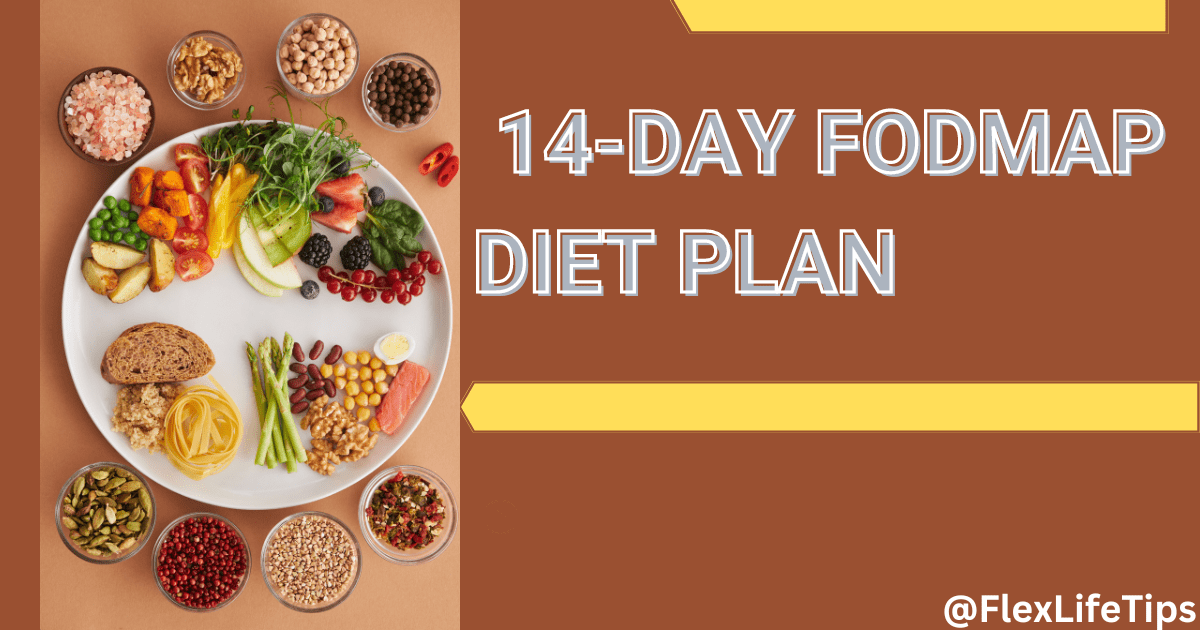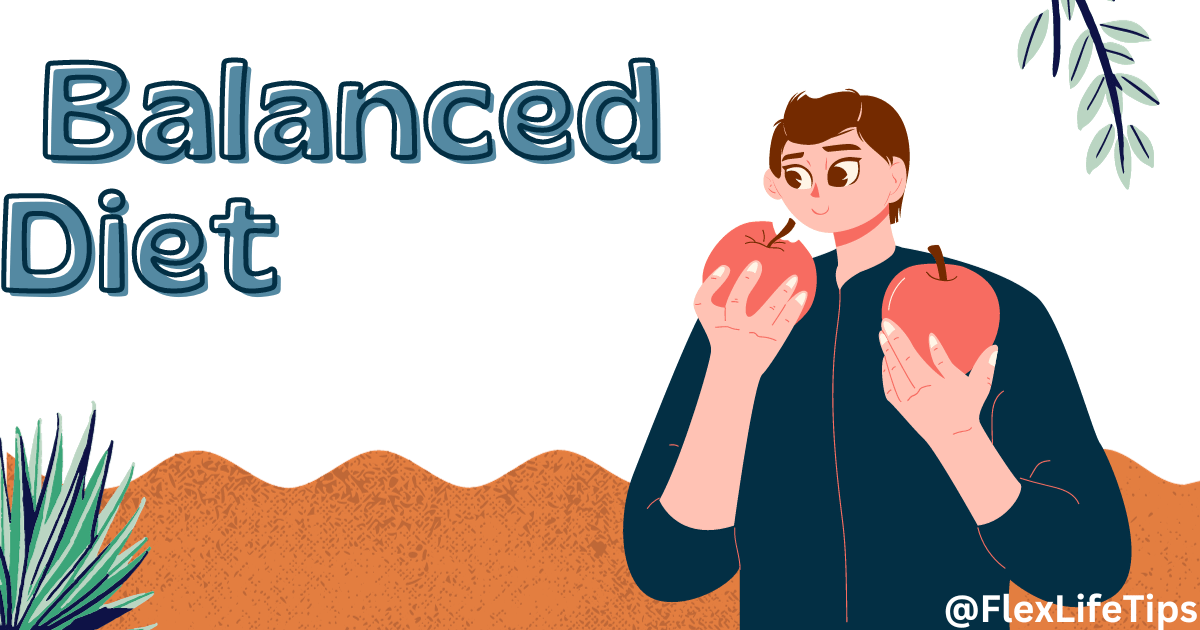Discover the transformative power of a 14-day FODMAP diet plan. This structured approach helps alleviate digestive discomfort by identifying trigger foods and restoring gut health. Start your journey to improved well-being with our comprehensive FODMAP-friendly meal plans and expert guidance.
Introduction
Welcome to your 14-Day FODMAP Diet Plan guide – your key to unlocking a healthier, happier gut! If you’ve ever wondered about the impact of FODMAPs on your digestive well-being, you’re in the right place. In this concise yet comprehensive blog, we’ll navigate the intricacies of the 14-day FODMAP diet plan, offering you a straightforward roadmap to understand better and manage your digestive health.
Discover the simplicity of this approach as we break down the elimination and reintroduction phases, provide practical meal plans, and share success stories that make a FODMAP-friendly lifestyle not just attainable, but enjoyable. Get ready to embark on a journey that can transform the way you eat and feel – let’s dive into the 14-Day FODMAP Diet Plan!
1. Getting Started 14-day FODMAP diet plan
Embarking on your 14-Day FODMAP Diet Plan is a simple yet powerful decision for a healthier digestive system. Here’s a guide to help you kickstart your journey:

Preparation is Key: Before diving into the 14-day FODMAP diet plan, take a moment to prepare yourself mentally and physically. Clear out your pantry of high-FODMAP foods, and make a shopping list of FODMAP-friendly alternatives. Having a well-thought-out plan will set you up for success.
Understanding FODMAPs: FODMAPs, which stands for Fermentable Oligosaccharides, Disaccharides, Monosaccharides, and Polyols, are certain types of carbohydrates that can trigger digestive discomfort in some individuals. The 14-day FODMAP diet plan involves eliminating high-FODMAP foods during the first week to identify and manage these triggers.
FODMAP Foods to Avoid: During the elimination phase, steer clear of high-FODMAP foods such as onions, garlic, wheat, dairy, certain fruits, and sweeteners. Opt for low-FODMAP alternatives like rice, potatoes, carrots, and lactose-free dairy products.
Keep It Simple: Simplicity is the key to success. Focus on whole, unprocessed foods to make your meals. Lean proteins, vegetables, and gluten-free grains are excellent choices. Explore herbs and spices to add flavor without FODMAP overload.
Track Your Progress: Consider keeping a food diary to track your meals and any digestive symptoms. This will help you identify patterns and make adjustments as needed. Note how you feel after each meal and notice any changes in your digestion.
By laying the groundwork with these simple steps, you’re setting yourself up for a successful and satisfying 14-day FODMAP diet plan. In the next section, we’ll delve into the specifics of the Elimination Phase, guiding you through the initial days of your journey. Get ready to experience the positive impact of the 14-Day FODMAP Diet Plan on your digestive well-being!
2. Week 1: Elimination Phase
Welcome to the crucial first week of your transformative 14-day FODMAP diet plan! This phase is designed to cleanse and reset your digestive system by eliminating high-FODMAP foods. Let’s break it down:

Day 1-3: Cleanse and Reset Start your 14-day FODMAP diet plan with a clean slate. Focus on simple, nourishing meals that are easy on your digestive system. Opt for low-FODMAP vegetables, lean proteins, and gluten-free grains. This initial phase allows your body to adjust to the absence of high-FODMAP foods.
Day 4-7: Exploring Low-FODMAP Foods As you progress through the week, begin incorporating a variety of low-FODMAP foods into your meals. Experiment with different vegetables, fruits, and grains to add diversity and flavor to your diet. Remember to closely monitor your body’s responses, noting any improvements or lingering symptoms.
Sample Meal Plans: Consider structuring your meals around a combination of protein, vegetables, and low-FODMAP grains. For breakfast, try a smoothie with lactose-free yogurt, banana, and berries. Lunch could include grilled chicken with a side of quinoa and steamed carrots, while dinner might feature salmon with roasted potatoes and zucchini.
Hydration Matters: Don’t forget the importance of staying hydrated. Water, herbal teas, and low-FODMAP fruit-infused drinks can be excellent choices to keep your body well-hydrated throughout the elimination phase.
Managing Challenges: During the elimination phase, you might encounter challenges such as cravings or the temptation to consume high-FODMAP foods. Stay focused on the goal and remind yourself of the benefits of completing the 14-day FODMAP diet plan. Engage in activities that distract you from cravings, and consider reaching out to a support system for encouragement.
By the end of the Elimination Phase, you’ll have successfully paved the way for the next stage of your 14-day FODMAP diet plan the Reintroduction Phase. Stay tuned as we guide you through the process of reintroducing FODMAPs and finding what works best for your individual digestive needs. The journey to a happier gut continues!
3. Week 2: Reintroduction Phase
Congratulations on completing the Elimination Phase of your 14-day FODMAP diet plan! Now, let’s delve into the equally important Reintroduction Phase, where you’ll systematically reintroduce specific FODMAP groups to gauge your tolerance levels.
Day 8-10: Reintroducing FODMAPs In this phase, you’ll reintroduce one FODMAP group at a time, spacing them out over a few days. Begin with a small amount and gradually increase to assess your body’s response. Common FODMAP groups to reintroduce include fructans, galacto-oligosaccharides (GOS), lactose, fructose, and polyols.
Day 11-14: Assessing Your Tolerance As you reintroduce FODMAPs, pay close attention to any symptoms or changes in your digestive well-being. Keep a detailed record of what you eat and how you feel afterward. This meticulous tracking will help you identify specific FODMAPs that may trigger discomfort, allowing you to tailor your diet accordingly.
Sample Reintroduction Schedule:
- Day 8-9: Reintroduce fructans (found in wheat, onions, and garlic).
- Day 10-11: Reintroduce GOS (found in legumes and certain nuts).
- Day 12-13: Reintroduce lactose (found in dairy products).
- Day 14: Reintroduce fructose and polyols (found in certain fruits and sweeteners).
Interpreting Results: After each reintroduction, assess how your body reacts. Common symptoms may include bloating, gas, diarrhea, or constipation. If you experience discomfort, consider scaling back on the reintroduced FODMAP and consult with a healthcare professional for guidance.
Long-Term Strategies: The insights gained during the Reintroduction Phase will guide your long-term approach to a FODMAP-friendly lifestyle. Armed with knowledge about your specific triggers, you can create a sustainable and balanced diet that supports your digestive health.
Celebrating Progress: Completing the Reintroduction Phase is a significant achievement on your 14-day FODMAP diet plan journey. Celebrate your progress and use this newfound understanding of your body to make informed choices for a healthier future.
Stay tuned as we explore sample meal plans, cooking tips, and strategies for maintaining a FODMAP-friendly lifestyle beyond the initial 14 days. The road to digestive well-being continues, and you’re on the right track!
4. Sample Meal Plans
Unlocking the full potential of your 14-day FODMAP diet plan involves crafting delicious and satisfying meals that align with your digestive goals. Here are some sample meal plans to inspire your culinary journey:

Breakfast Ideas:
- Blueberry Banana Smoothie:
- Ingredients: Lactose-free yogurt, banana, blueberries, and a sprinkle of chia seeds.
- Method: Blend for a refreshing and FODMAP-friendly start to your day.
- Quinoa Breakfast Bowl:
- Ingredients: Cooked quinoa, strawberries, and a drizzle of maple syrup.
- Method: Combine the ingredients for a hearty and nutritious breakfast option.
Lunch Options:
- Grilled Chicken Salad:
- Ingredients: Grilled chicken, mixed salad greens, cherry tomatoes, and homemade olive oil and lemon dressing.
- Method: Toss together for a light and satisfying lunch.
- Turkey and Cranberry Wrap:
- Ingredients: Sliced turkey, lactose-free cheese, cranberry sauce, and lettuce wrapped in a gluten-free tortilla.
- Method: Assemble for a flavorful and portable lunch option.
Dinner Recipes:
- Salmon and Quinoa Stir-Fry:
- Ingredients: Salmon fillet, quinoa, bell peppers, zucchini, and a low-FODMAP stir-fry sauce.
- Method: Stir-fry the ingredients for a quick and nutritious dinner.
- Baked Chicken with Roasted Vegetables:
- Ingredients: Chicken breast, carrots, potatoes, and green beans tossed in olive oil and herbs.
- Method: Bake for a delicious and easy-to-prepare dinner.
Snack Suggestions:
- Mixed Nuts and Seeds:
- Ingredients: Almonds, walnuts, and pumpkin seeds.
- Enjoy a handful as a satisfying and nutrient-rich snack.
- Lactose-Free Yogurt with Berries:
- Ingredients: Lactose-free yogurt topped with strawberries or blueberries.
- A quick and delicious snack to curb your cravings.
These sample meal ideas showcase the versatility and variety of a FODMAP-friendly diet. Feel free to experiment with flavors and ingredients to find combinations that suit your taste preferences. As you navigate your 14-day FODMAP diet plan, let these meal plans be a source of inspiration for creating nourishing and enjoyable dishes.
5. Grocery Shopping Guide
Navigating the aisles with a clear understanding of FODMAPs is essential for success in your 14-day FODMAP diet plan. Here’s a handy grocery shopping guide to help you make informed choices:
FODMAP-Friendly Foods:
- Proteins:
- Opt for lean proteins such as chicken, turkey, fish, and tofu.
- Consider eggs as they are generally well-tolerated.
- Vegetables:
- Choose low-FODMAP vegetables like carrots, zucchini, spinach, kale, and bell peppers.
- Avoid high-FODMAP options like onions, garlic, and asparagus.
- Fruits:
- Stick to low-FODMAP fruits such as berries, grapes, kiwis, and oranges.
- Limit high-FODMAP fruits like apples, cherries, and watermelon.
- Grains:
- Opt for gluten-free grains like rice, quinoa, and oats.
- Avoid wheat-based products, including regular bread and pasta.
- Dairy:
- Select lactose-free or low-lactose dairy products, such as lactose-free milk and hard cheeses.
- Steer clear of high-lactose items like regular milk and soft cheeses.
Reading Food Labels:
- Check for FODMAP Content:
- Scrutinize labels for ingredients containing high-FODMAP substances like fructose, lactose, and polyols.
- Be cautious of hidden sources of FODMAPs in sauces, dressings, and processed foods.
- Look for Certified Products:
- Seek out products with FODMAP-friendly certifications to simplify your shopping experience.
- Some brands clearly label their products as suitable for a low-FODMAP diet.
By arming yourself with this grocery shopping guide, you’ll confidently select foods that align with your 14-day FODMAP diet plan. Remember, simplicity is key, and by focusing on whole, unprocessed foods, you’ll make the most of your journey toward digestive well-being. Happy shopping!
8. Success Stories
Embarking on a 14-day FODMAP diet plan can yield transformative results, and hearing about the success stories of others can be both inspiring and reassuring. Here, we share real-life experiences that highlight the positive impact of the 14-day FODMAP diet plan on digestive health:
Real-Life Experiences:
- Sarah’s Journey to Digestive Freedom:
- Sarah, a 34-year-old marketing professional, struggled with persistent bloating and abdominal discomfort. After completing the 14-day FODMAP diet plan, she experienced a significant reduction in symptoms. Sarah shares, “The simplicity of the plan made it easy to follow, and I learned so much about my body’s response to different foods. It’s been a game-changer for me.”
- Mike’s Triumph Over Digestive Discomfort:
- Mike, a 45-year-old teacher, faced challenges with irregular bowel habits and gas. Through the 14-day FODMAP diet plan, he identified specific triggers and adjusted his diet accordingly. “I used to dread mealtime, but now I have a better understanding of what works for my digestive system. The plan gave me back control over my gut health.”
Positive Outcomes:
- Improved Quality of Life:
- Many individuals report a significant improvement in their overall quality of life after completing the 14-day FODMAP diet plan.
- Reduced symptoms contribute to increased energy, better mood, and a more positive outlook on daily activities.
- Enhanced Dietary Awareness:
- Success stories often highlight a newfound awareness of dietary choices and their impact on digestive health.
- Individuals learn to make informed decisions about food, leading to a healthier relationship with what they consume.
Tips from Those Who Succeeded:
- Consistency is Key:
- Successful participants emphasize the importance of consistency in following the 14-day FODMAP diet plan.
- Adhering to the plan allows the body time to adjust and provides a clearer picture of individual triggers.
- Listen to Your Body:
- Paying attention to subtle cues from the body is crucial for success.
- Successful individuals stress the importance of being attuned to how different foods affect them personally.
Encouraging Others:
- Community Support:
- Joining FODMAP-friendly communities online or in person can provide additional support and encouragement.
- Sharing experiences and tips with others on a similar journey creates a sense of community.
- Persistence Pays Off:
- Success stories often highlight the value of persistence and a positive mindset.
- Despite challenges, those who succeed in their 14-day FODMAP diet plan emphasize the importance of staying committed to the process.
As you embark on your 14-day FODMAP diet plan, remember that success is not only measured by the absence of symptoms but also by the knowledge gained about your body and its unique needs. These real-life stories serve as a testament to the transformative potential of the plan and offer hope to those seeking relief from digestive discomfort. Stay committed, stay positive, and celebrate your own success story in the making!
What do I eat in a day on a low FODMAP diet?
A typical day on a low FODMAP diet might include meals such as oatmeal with strawberries and lactose-free milk for breakfast, grilled chicken with quinoa and steamed carrots for lunch, and salmon with roasted potatoes and green beans for dinner. Snacks could include rice cakes with peanut butter and banana slices or lactose-free yogurt with a handful of blueberries.
How long does it take to see results from a FODMAP diet?
Many people start to notice improvements in their symptoms within the first two weeks of following a FODMAP diet. However, it can vary depending on individual factors such as the severity of symptoms and adherence to the diet.
Do you lose weight on a FODMAP diet?
The primary goal of a FODMAP diet is to manage symptoms of digestive discomfort, rather than weight loss. However, some people may experience weight loss as a result of reducing certain high-calorie, high-FODMAP foods from their diet, particularly if they were previously contributing to bloating or fluid retention.
What are the negatives of a FODMAP diet?
While a FODMAP diet can be effective for managing symptoms of irritable bowel syndrome (IBS) and other digestive issues, some potential negatives include the restriction of certain nutritious foods, the complexity of navigating the diet, and the need for strict adherence, which can be challenging for some individuals.
Can I eat peanut butter on a low FODMAP diet?
Yes, you can typically consume peanut butter on a low-FODMAP diet, but it’s important to choose varieties without added high-FODMAP ingredients such as honey or high-fructose corn syrup. Opt for natural peanut butter made with just peanuts and salt to ensure it aligns with the low FODMAP guidelines.
Is coffee a low-FODMAP food?
Coffee itself is considered low in FODMAPs. However, some individuals may experience digestive discomfort due to its acidic nature or caffeine content. If you find that coffee triggers symptoms for you, consider limiting your intake or opting for low-acid or decaffeinated varieties. Additionally, be mindful of high-FODMAP additives like milk or sweeteners that are often added to coffee.



